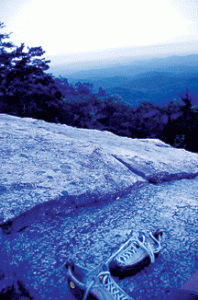Stewards of the Rock
Story and Photos by Megan Naylor
Bouldering is a sport of strength, power and dynamics focusing on pure contact with the rock, free from harnesses, ropes and racks of gear.
It brings both climber and rock together in a rhythmic balance of fluid grace and technical moves.
What began as a niche sport is now becoming increasingly popular, with people drawn to the technical challenge of traversing rock uninhibitedly and to the sport’s low start up cost on gear.
Bouldering Issues and Impacts
As more people seek out the beautiful strong rock scattered across the Appalachian Mountains, stewardship of the land becomes more of a concern.
“Areas that see a lot of people can quickly show signs of wear,” Amy Ansari said, Grassroots Organizer for The Access Fund. “People may not notice right away but often the vegetation struggles to grow back.”
Because many bouldering areas in the Southeast are located on private property or accessed by it, friction often occurs between climbers and landowners regarding issues such as trespassing, parking, litter and noise.
Environmental damage can ensue from lack of knowledge concerning the footprint inflicted on heavily trafficked areas.
Erosion, loss of vegetation, habitat loss and introduction of invasive species often occurs at trails leading between rock faces and at crash pad areas where spotters facilitate safe landings should climbers fall.
Solutions through Stewardship
Organizations such as The Access Fund and local climbers coalitions are working to mitigate environmental damage and establish cooperation between landowners and individual climbers.
The Access Fund, a national climber’s advocacy organization founded in 1990, focuses on keeping U.S. climbing areas open while also providing guidance to climbers, climbing organizations and landowners on management strategies. Nationally, they lobby legislature toward mutually agreeable policies concerning the sport.
“We work to educate federal agencies on what climbing is and why it is important to create policies that balance recreation and conservation, while also working with climbers and organizations on how to work proactively with landowners,” Ansari said.
Climbing coalitions also exist across the nation to promote stewardship and access on a smaller scale.
According to Anthony Love, president of the Carolina Climbers Coalition, the best way to address private property and liability issues is by being informed of whose land you are on and to ask for public access permission with the help of the local climbing organization.
“Many landowners are worried about liability,” Love said. “But in North Carolina and many states, private landowners who open their land for public recreation use are protected from liability of those recreating on their land by recreational user statutes.”
Misty Mountain Threadworks, an internationally known climbing company based in Boone, N.C., also shares the view that climbing is about more than getting to the top.
“Even though ninety-nine percent of climbers pick up after themselves, sadly there will always be that one percent that don’t,” said Goose Kearse, co-owner of Misty Mountain Threadwords.
Misty doesn’t have a specific program for stewardship, instead their business practices and lifestyles reflect the environmental ideals they hold.
“As climbers we want to protect the places we love and lessen our impact,” Kearse said. “So we recycle as much as possible and cut down on production waste within our company and sponsor local events such as Adopt-a-Crag.”
Initiated by The Access Fund, Adopt-a-Crag is the largest climbing volunteer project in the country, and involves an average of 160 events.
Adopt-a-Crag events typically include litter cleanups, trail construction and restoration, erosion control and invasive weed removal.
According to Ansari, these events are aimed at highlighting climber conservation at the local level, demonstrating to landowners and land managers that climbers care about the places they recreate.
Local coalitions across the country team up and choose boulder-fields and other climbing areas that deserve a little extra love.
“Whenever you can, try to carpool and when bouldering, try to minimize your footprint by minimizing trash generated,” said Love. “Please be sensitive to vegetation and trees and avoid climbing in large groups as it concentrates the impact to immediate areas.”
Across the board, the resounding response to the question of how climbers can preserve boulders and routes they are passionate about is by being responsible for their own individual impact.
“We shouldn’t leave things the way we found them, we should leave them better then when we arrive,” said Kearse.
For more information on bouldering stewardship and how to get involved visit AccessFund.org or CarolinaClimbers.org.
Related Articles
Latest News

Leave a comment
Your email address will not be published. Required fields are marked *







Leave a Comment